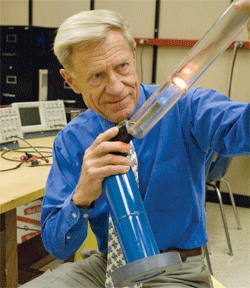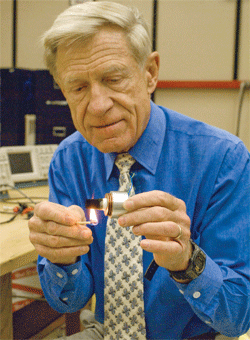Acoustic devices convert heat into electricity
Small devices use sound to create energy from waste heat
University of Utah physicist Professor Orest Symko and five of his doctoral students have developed small devices that can convert waste heat into electricity, harness solar energy, and cool computers and radar equipment–all by turning heat into sound and then into electricity. “We are converting waste heat to electricity in an efficient, simple way by using sound,” Symko said. “It is a new source of renewable energy from waste heat.”

Physicist Orest Symko demonstrates how heat can be converted into sound by using a blowtorch to heat a metallic screen inside a plastic tube, which then produces a loud tone. Photo courtesy of The University of Utah
When I asked Symko why this middle step (turning heat into sound) is necessary, he maintained “That is the nature of our device.” But, while he admitted that there are other systems, thermoelectric devices, that do not require this extra step, he contends “they are not efficient.”
How they’re doing it
The process comprises two key steps. Various new heat enginesthermoacoustic prime moversconvert heat into sound, which is then converted into electricity using piezoelectric devices. The efficiency of piezoelectric devices during this final conversion is key to keeping loss minimized, Symko said.
Most of the heat-to-electricity acoustic devices built in Symko’s laboratory are housed in cylinder-shaped “resonators” that fit in the palm of your hand. Each resonator contains a stack of material with a large surface area–such as metal or plastic plates, or fibers made of glass, cotton or steel wool–placed between a cold heat exchanger and a hot heat exchanger.

Symko holds a match to a small heat engine that produces a high-pitched tone by converting heat into sound. Photo courtesy of The University of Utah
When heat is applied, it builds to a threshold and the moving air produces sound at a single frequency, similar to air blown into a flute. “You have heat, which is so disorderly and chaotic, and all of a sudden you have sound coming out at one frequency,” Symko said. Then the sound waves squeeze the piezoelectric device, producing an electrical voltage. Symko says it’s similar to what happens if you hit a nerve in your elbow, producing a painful electrical nerve impulse.
Devices that convert heat to sound and then to electricity lack moving parts, so such devices will require little maintenance and last a long time. They do not need to be built as precisely as, say, pistons in an engine, which loses efficiency as the pistons wear.

Symko uses a battery to heat the device in his hands. The device changes the heat to audible sound, and then converts the sound into an electric current that makes the light bulb glow faint red.
Researchers expect the devices could be used within two years as an alternative to photovoltaic cells for converting sunlight into electricity. The heat engines also could be used to cool laptops and other computers that generate more heat as their electronics grow more complex. And Symko foresees using the devices to generate electricity from heat that now is released from nuclear power plant cooling towers.
Ralph Raiola
To comment on this article or to see what others are thinking, visit the EEbeat post at http://www.eebeat.com/?p=641.
Advertisement
Learn more about Electronic Products Magazine





